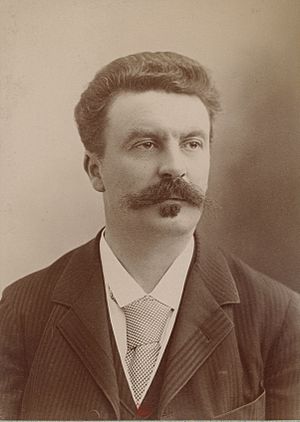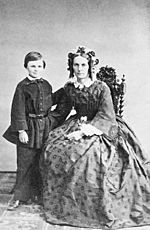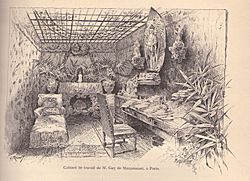Guy de Maupassant facts for kids
Quick facts for kids
Guy de Maupassant
|
|
|---|---|
 |
|
| Born | Henri René Albert Guy de Maupassant 5 August 1850 Tourville-sur-Arques, French Republic |
| Died | 6 July 1893 (aged 42) Passy, Paris, French Republic |
| Resting place | Montparnasse Cemetery |
| Pen name | Guy de Valmont, Joseph Prunier |
| Occupation | Novelist, short story writer, poet |
| Genre | Naturalism, Realism |
| Signature | |
Guy de Maupassant (5 August 1850 – 6 July 1893) was a popular 19th century French writer. He is considered one of the fathers of the modern short story.
Biography
Henri-René-Albert-Guy de Maupassant was born on 5 August 1850 at the late 16th-century Château de Miromesnil (near Dieppe in the Seine-Inférieure (now Seine-Maritime) department in France). He was the first son of Laure Le Poittevin and Gustave de Maupassant, who both came from prosperous bourgeois families.
When Maupassant was 11 and his brother Hervé was five, his mother, an independent-minded woman, risked social disgrace to obtain a legal separation from her husband, who was violent towards her.
After the separation, Laure Le Poittevin kept her two sons. In the absence of the father, Maupassant's mother became the most influential figure in the young boy's life. She was an exceptionally well-read woman and was very fond of classical literature, particularly Shakespeare. Until the age of thirteen, Guy lived happily with his mother, at Étretat in Normandy. At the Villa des Verguies, between the sea and the luxuriant countryside, he grew very fond of fishing and of outdoor activities. When Guy reached the age of thirteen, his mother placed her two sons as day boarders in a private school, the Institution Leroy-Petit, in Rouen—the Institution Robineau of Maupassant's story La Question du Latin—for classical studies.
In 1867, as he entered junior high school, Maupassant met Gustave Flaubert at Croisset at the insistence of his mother. Next year, in autumn, he was sent to the Lycée Pierre-Corneille in Rouen where he proved a good scholar, indulging in poetry and taking a prominent part in theatricals.
Gustave Flaubert took him under his protection and acted as a kind of literary guardian to him, guiding his debut in journalism and literature. At Flaubert's home he met Émile Zola (1840-1902) and the Russian novelist Ivan Turgenev (1818-1883), as well as many of the proponents of the realist and naturalist schools.
In 1878, he became a contributing editor to several leading newspapers such as Le Figaro, Gil Blas, Le Gaulois and l'Écho de Paris. He devoted his spare time to writing novels and short stories.
In 1880 he published what is considered his first masterpiece, "Boule de Suif", which met with instant and tremendous success.
The decade from 1880 to 1891 was the most fertile period of Maupassant's life. Made famous by his first short story, he worked methodically and produced two or sometimes four volumes annually. His talent and practical business sense made him wealthy.
In 1881 he published his first volume of short stories under the title of La Maison Tellier; it reached its twelfth edition within two years. In 1883 he finished his first novel, Une Vie (translated into English as A Woman's Life), 25,000 copies of which were sold in less than a year. His second novel, Bel-Ami, which came out in 1885, had thirty-seven printings in four months.
His editor, Havard, commissioned him to write more stories, and Maupassant continued to produce them efficiently and frequently. At this time he wrote what many consider his greatest novel, Pierre et Jean (1888).
He traveled extensively in Algeria, Italy, England, Brittany, Sicily, and the Auvergne, and from each voyage brought back a new volume.
Flaubert continued to act as his literary godfather.
In his later years Maupassant suffered from a number of health issues and developed a constant desire for solitude, an obsession for self-preservation, and a fear of death. Due to his declining health, he was committed to the private asylum of Esprit Blanche at Passy, in Paris, where he died (6 July 1893).
Maupassant penned his own epitaph: "I have coveted everything and taken pleasure in nothing." He is buried in Section 26 of the Montparnasse Cemetery, Paris.
Works
Maupassant's stories depicted human lives in realistic and often pessimistic terms. Many of his stories are set during the Franco-Prussian War of the 1870s, describing the civil side of war and the innocent civilians who, caught up in events beyond their control, are permanently changed by their experiences. He wrote 300 short stories, six novels, three travel books, and one volume of verse. His first published story, "Boule de Suif" ("The Dumpling", 1880), is often considered his masterpiece.
Maupassant's stories and writing style influenced many writers including Somerset Maugham and O. Henry. Two of his stories about real or fake jewels ("La parure", "Les bijoux") are imitated with a twist by Maugham ("Mr Know-All", "A String of Beads") and Henry James ("Paste"). As a stylish writer with a huge popular appeal he may be compared to Georges Simenon.
Maupassant also wrote under several pseudonyms such as Joseph Prunier, Guy de Valmont, and Maufrigneuse (which he used from 1881 to 1885).
Most famous short stories
- Ball-of-Fat (1880)
- Mme. Tellier's Establishment (1881)
- Mademoiselle Fifi (1882)
- Vendetta (1883)
- Mother Savage (1884)
- Miss Harriet (1884)
- My Uncle Jules (1884)
- A Piece of String (1884)
- The Necklace (1885)
- A Way to Wealth (1885)
- The Horla (1887)
Images for kids
See also
 In Spanish: Guy de Maupassant para niños
In Spanish: Guy de Maupassant para niños








